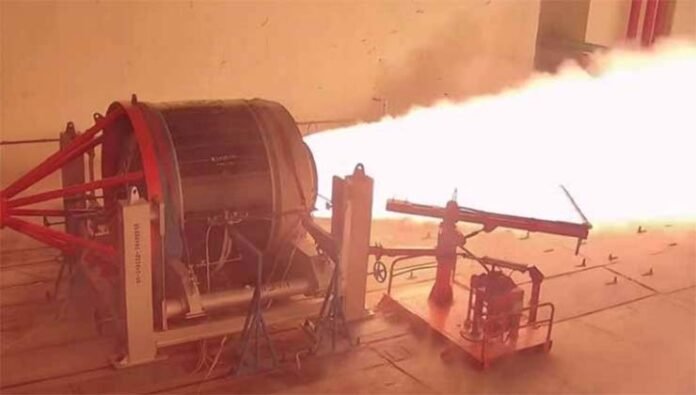New Delhi: DRDO’s Armament & Combat Engineering (ACEM) facility has successfully conducted the static test of the Stage-2 rocket motor for the K-5 submarine-launched ballistic missile (SLBM).
The K-5 SLBM is designed with an operational range of approximately 5,000 kilometres, matching the striking capability of land-based Agni-5 missiles.
This missile represents a critical component of India’s strategic nuclear deterrence, intended for deployment on the Arihant-class nuclear submarines.
The static test verifies the performance and reliability of the Stage-2 solid rocket motor, a crucial propulsion segment in the missile’s three-stage configuration.
The K-5 missile features a three-stage solid-fuelled system manufactured using composite materials to enhance strength while reducing weight.
The thrust generated during the static test ensures the rocket motor meets required parameters for burn time, thrust, and structural integrity under operational conditions.
This successful test underscores DRDO’s progress in indigenous development of advanced SLBM technology and contributes to strengthening undersea nuclear deterrence capabilities.
The missile can carry a nuclear payload of up to 2 tonnes and supports Multiple Independently Targetable Reentry Vehicle (MIRV) technology for engaging multiple or highly secure targets.
Cold-launch technology is employed, which uses gas pressure to eject the missile from the submarine launch canister before rocket ignition, reducing acoustic and thermal signatures underwater.
With a length of about 12 metres and diameter of 2.45 metres, the K-5 shares design similarities with the Russian R-39 SLBM but is tailored for Indian strategic requirements.
Earlier stages of K-5 development included completion announcements in mid-2025 and integration preparations with the extended Arihant-class submarines, codenamed S4 and S4*.
This Stage-2 motor static test is one of several crucial steps progressing towards the missile’s maiden underwater launch trials, expected soon.
The test was conducted at DRDO’s ACEM facility in Hyderabad, which specialises in propulsion and energetic materials for missile applications.
The success reflects enhanced propulsion technology capabilities, advanced materials engineering, and rigorous quality assurance in Indian missile manufacturing.
K-5 forms the backbone of India’s sea-based nuclear triad, enhancing second-strike capabilities with extended range and rapid response.
Follow-up steps will include full missile integration testing, system checks on MIRV deployment mechanisms, and eventual launch validation from submarine platforms.
This accomplishment marks a significant milestone in the ongoing K-series SLBM programme, securing India’s strategic interests at sea with credible underwater deterrence.
DRDO continues to work on the K-6 missile with even longer range and hypersonic capabilities, complementing K-5 in the future strategic arsenal.
The static test confirms the robust development trajectory of the K-5 SLBM and its readiness for subsequent operational trials, bolstering India’s defence posture at strategic depth.





